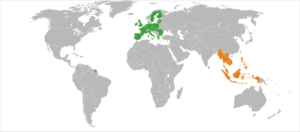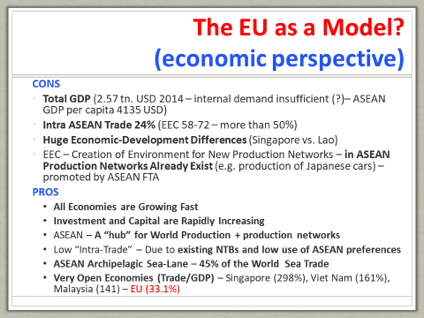A comparison between the operating modes of the European Union and those of the ASEAN countries.
 Is it possible that there are ways of cooperation between the various countries of the European Union that are different and perhaps better than those in force today? The answer to this question is an obvious “Yes sure”.
Is it possible that there are ways of cooperation between the various countries of the European Union that are different and perhaps better than those in force today? The answer to this question is an obvious “Yes sure”.
Obviously, because the alternative: “No, the existing model today represents the optimum” – would betray an excess of confidence and a lack of willingness to re-examine and, where necessary, improve the model. However, it is not uncommon for various Brussels officials to respond to this question with a sharp “TINA” – There is no alternative. We scholars, on the other hand, ask ourselves the question every day to try to understand the areas that need attention because sometimes a step backwards or simply stopping to reflect is, in reality, a step forward. But in Brussels, the belief is Ever closer integration, without anyone ever explaining why – in fact, I correct myself: at a dinner, a representative of the European Commission, after a heated debate on the economic benefits of the Euro, the common market, the re-distributive effects on income, on the increase in poverty, the decline in living standards, suddenly told me: “Michele, do not you understand: the economic well-being of the European citizen citizens is a secondary goal that needs to obey the political objective to create a European State. If people get poorer along the way, so be it “.
With this premise, today I want to talk about the free market of goods, one of the four pillars of the European Union, together with the free movement of services, capital and citizens. In particular, I compare the operational modalities of the European Union with those of the ASEAN countries, the ten countries of Southeast Asia, which have also set up an economic free trade area: ASEAN Economic Community – AEC – but with fundamental differences.
In short, the European Union has adopted a model of a customs union with a single tariff and free movement of goods within. The EU imposes duties on the borders of the Union for goods imported from third countries to be received by all member countries. While, goods produced within the Union can be exported to other EU countries without duties.
Asean has instead adopted a model of a free trade zone with the rule of origin and leaves every country free to impose the duties it wishes for products imported from third countries, not part of the AEC – always respecting the rules of the WTO. However, these goods, if re-exported to other countries of the AEC, will be subject to duties. On the contrary, only goods produced within the AEC area, for at least 40% of the added value, can freely circulate among the ten countries. The table below illustrates these differences.
| European Union | Asean | |
| Duties on imports from third countries | Duties for all products decided at the Community level. All countries apply the same duties to imports from non-EU countries. Example: for goods coming from China, the same duties are imposed regardless of whether the country of destination is Italy or France. |
Each of the 10 countries is free to impose the duties it deems appropriate. There is no common policy for imports from third countries. Example: for goods coming from China, different duties are imposed depending on whether the recipient country is Vietnam or Cambodia (according to WTO rules, however) |
| Duties on imports from countries belonging to the Single Market area | Zero duties for any type of goods. | Final objective: a single market with zero duties for goods produced within the area. To date, there is a regime of gradual reduction of duties (currently around 0% -5%), with a softer target for agricultural products (rice), which remain a bit ‘more protected. |
| Rule of Origin | It is not necessary, because all the goods that are already in one of the EU countries are either
a) produced in EU and therefore not subject to duties Or b) imported from a non-EU country and therefore already subject to duties. |
Goods are considered “Produced in Asean” if at least 40% of the added value is produced within the area. Goods that meet this condition can be exported to the other 9 countries at reduced rates (or zero, as discussed above). Goods that do not meet this criterion are subject to discretionary duties by the importing country, subject to the rules of the WTO, World Trade Organization. |
What are the advantages and disadvantages of one and the other approach?
To answer this question, I use data and slides (AEC Cambridge EU vs Asean) of my friend Professor Claudio Dordi, an International trade expert, who teaches at Bocconi, as well as Team Leader of the multi-lateral EU-Vietnam project which led to the signing of a free trade agreement between Vietnam and the European Union. Thus, a person who understands the issues and looks at the problem from his privileged observatory in Hanoi.
He highlights how an EU model, if applied to the ASEAN countries, would have, on one hand the disadvantages, such as the great economic differences between, for example Singapore and Laos, and the low degree of commercial integration in the ASEAN countries, where the value of intra-area trades is only 24% of the total against 50% of the EU. In other words, the European Union is more commercially integrated. On the other hand, if the ASEAN countries adopted the EU model, there would also be advantages, since all the economies of Southeast Asia have high growth rates and levels of capital investment. More importantly still would be the elimination of Non-Tariff-Barriers (NTB), which still exist among the ten ASEAN countries, non-tariff barriers which, in the end, are those that still, despite the almost total absence of duties, make business difficult. For more complete information on the economic and legal functioning of the ASEAN area, I refer you to the complete set of slides by Prof Dordi.
 My last consideration is about the advantage that the ASEAN countries have towards EU countries, in terms of commercial flexibility towards third countries, not belonging to the area. The great difficulty that exists in Brussels is precisely to draw up a list of duties for all imported goods, which all 28 countries must adopt. 28 countries that have economic structures different from each other and where the lack or excess of certain goods cannot be the same in all countries. A uniform policy of duties tends to mediate different needs and, as often happens, it makes everyone unhappy. The ASEAN solves this problem by applying the rule of origin, and only goods produced locally are subject to free trade, leaving every country the freedom to impose duties on goods imported from third countries (in compliance with the WTO rules). However, the price to pay for this differentiation in the treatment of goods is the presence of hard or soft of borders between countries. In Europe, borders have naturally been cut down to allow free movement of individuals, a great achievement of the EU. But, a small check, from time to time, on the origin of goods passing through the 28 borders would not be bad… a soft Schengen for trade!
My last consideration is about the advantage that the ASEAN countries have towards EU countries, in terms of commercial flexibility towards third countries, not belonging to the area. The great difficulty that exists in Brussels is precisely to draw up a list of duties for all imported goods, which all 28 countries must adopt. 28 countries that have economic structures different from each other and where the lack or excess of certain goods cannot be the same in all countries. A uniform policy of duties tends to mediate different needs and, as often happens, it makes everyone unhappy. The ASEAN solves this problem by applying the rule of origin, and only goods produced locally are subject to free trade, leaving every country the freedom to impose duties on goods imported from third countries (in compliance with the WTO rules). However, the price to pay for this differentiation in the treatment of goods is the presence of hard or soft of borders between countries. In Europe, borders have naturally been cut down to allow free movement of individuals, a great achievement of the EU. But, a small check, from time to time, on the origin of goods passing through the 28 borders would not be bad… a soft Schengen for trade!

[…] just as it is the European single market, and that is also why the model of cooperation of the countries of Southeast Asia, Asean, is not based on a Custom Union, but on free trade based on the rule of the country of origin, a […]